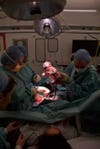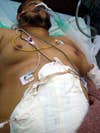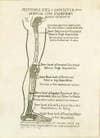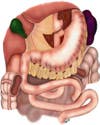Surgery dates back to Neolithic times, but some major advances have occurred in the last 20 years that have allowed for previously unthinkable procedures.
While many new techniques have been cool without being clinically relevant, PopSci spoke with with Jeffrey Matthews, the chairman of surgery at the University of Chicago Hospital, to look at some of the advances that have actually helped save lives. And as a bonus, we’ll look back at some aspects of surgery that haven’t changed over the decades.
Laparoscopy
Originally developed at the turn of the 20th century, it wasn’t until the 1980s that this technique really began to take off. Laparoscopy involves very small instruments inserted into a tiny hole, so the entire surgery can be performed without cutting open the patient. “It has rapidly transformed the way we think of surgeries in a lot of different contexts. It reduces recovery time, pain, and scarring,” says Matthews.
Endovascular Surgery
Similar to laparoscopy in that it is minimally invasive, endovascular surgery takes advantage of the body’s natural highway: the circulatory system. Doctors thread a catheter through major arteries, follow the progress of the line with real-time X-rays, and then deploy stents or coils to relieve aneurysms. “This gives us a new way to go after the problem,” says Matthews. “It allows us to avoid a big operation. Particularly, it allows the patient to avoid going on a heart/lung machine. And it also spurred, and continues to spur, the development of new biocompatible and drug-releasing materials.”
Robotic Surgery
Like something out of science fiction, the ’00s saw the development and advancement of doctors using robots to perform complex surgeries. This even enabled telesurgeries, like a 2001 procedure where doctors in New York City remotely operated a surgical robot in France to remove a woman’s gall bladder. “It has revolutionized prostate surgery. It’s disruptive: this will start a whole new paradigm,” says Matthews, although he cautioned that the price of the machines ($1.5 million for the most advanced robotic surgeons) brings up questions about the cost/benefit ratio of such procedures.
Microsurgery
Microsurgery also has a long legacy, but according to Matthews, microsurgery techniques have really changed over the last 15 years. Those changes have enabled never-before-attempted surgeries like face and hand transplants. “20 years ago, it was unthinkable [to transplant a face],” says Matthews. “It enables a whole new category of surgery.”
Fetal Surgery
The first fetal surgery was performed in 1980, but the procedure still remains rare. “That has not taken off yet, there are only a few places in the world where that’s done. Unimaginable in the past, and it’s a whole new type of surgery,” says Matthews, who notes that the number of fetal surgeries has greatly increased since 2000.
Live Organ Transplant
Live organ transplants take advantage of the body’s ability to grow back significant portions of the liver. Living donors give half of their healthy liver to an ailing relative, and then both the original and the transplanted liver pieces grow back to full size. The first surgery, performed in 1989, involved a Teresa Smith donating part of her liver to her infant child, Alyssa.
Caesarian Section
And now, on to the oldies but goodies! The caesarian section was first developed in antiquity (note the name of the procedure), and is still performed all the time.
Trauma Surgery
Trauma surgery may very well date back to the Neolithic, but entered into its modern form in the 1800s when large-scale conflicts like the Napoleonic Wars and the American Civil War provided doctors with a lot of trauma victims. “Someone gets shot, stabbed, in a car accident, you still have to go in there with big incisions like we did 100 years ago,” says Matthews. “If you get a shotgun blast to the abdomen, you’re still going to need a big surgery.”
Amputation
Amputation is another ancient surgery that has changed little over the centuries. “”We have many new ways to save a limb, but if the limb has to come off, it’s basically the same procedure as it was throughout history,” says Matthews.
Obesity Surgery
First developed in the 1960s, but abandoned due to the nutritional side effects caused by the surgery, gastric bypass surgery and stomach stapling have made a comeback in recent years. “The way the surgery was conceived, there were lots of bad nutritional implications,” says Matthews, “but as we learned more about it, the surgery got reintroduced. This has come back with a vengeance. It’s a very common operation that we can do in minimally invasive ways and we can make it very successful. Some would say it’s the only cure for the diabetes of obesity.”
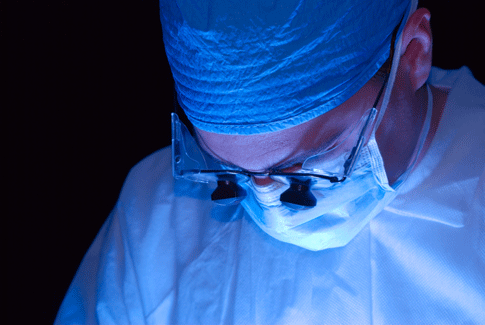

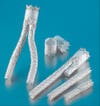

![Microsurgery also has a long legacy, but according to Matthews, microsurgery techniques have really changed over the last 15 years. Those changes have enabled never-before-attempted surgeries like face and hand transplants. "20 years ago, it was unthinkable [to transplant a face]," says Matthews. "It enables a whole new category of surgery."](https://www.popsci.com/uploads/2019/03/18/7E4HM4BDFAD2GIY2CE2N44J4WM.jpg?auto=webp&optimize=high&width=100)


